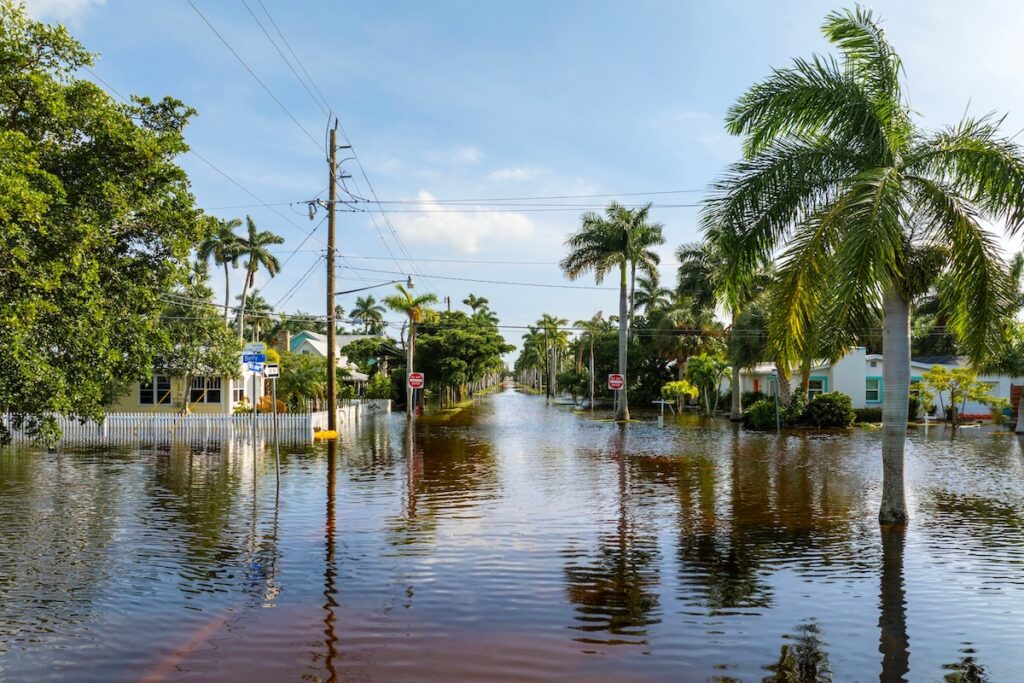
Flooding from last year’s hurricane Milton rainfall in Punta Gorda, Florida. (Bilanol/Shutterstock)
A new artificial intelligence tool could make flood forecasts more accurate and actionable, according to a study published in AGU Advances. Researchers found that combining a machine learning model with the U.S. National Oceanic and Atmospheric Administration’s (NOAA) National Water Model significantly improved the accuracy of national-scale flood predictions.
The system, called Errorcastnet, was developed by a team led by scientist Vinh Ngoc Tran at the University of Michigan. Based on a neural network, Errorcastnet acts as a correction layer for NOAA’s process-based model, identifying and learning from systematic errors in past forecasts. When integrated with the National Water Model, the hybrid approach boosted accuracy by a factor of four to six across lead times of one to ten days, the researchers reported. The findings show how, rather than replacing physics-based systems with AI, scientists are now exploring ways to combine the strengths of both.
Pairing Physics With Machine Learning
NOAA’s National Water Model simulates and forecasts conditions for rivers and streams across the contiguous United States, providing updates multiple times per day. The model draws data from nearly 11,000 operational water gauges that measure rainfall, runoff, and river flow. The model also factors in vegetation, urban development, and drainage patterns for more hydrologic accuracy.
Forecasting errors occur when these complex interactions are incompletely modeled or when local data gaps exist. Lead researcher Tran and his colleagues trained their neural network on years of NOAA data, including rainfall and flooding records, to help identify where and why those mismatches occurred.

Interactive NOAA map of the National Water Model. Each colored dot is a water gauge that has information on flood potential. (Credit: NOAA)
“So especially for floods, the performance of the pure AI model is quite poor,” said Tran in an AGU release. “The advantage of the AI models is that they are very simple. You only need to use the data to train the model and provide the forecast, but the most important thing we need to be concerned about is ensuring prediction accuracy for flood events that can cause significant damage.”
Errorcastnet’s role is to analyze the historical performance of the National Water Model, determine which types of errors can be corrected, and refine the outputs accordingly. Some errors, such as those linked to physical limitations or missing data, cannot be fixed but can add to the system’s ongoing training.
“You can’t throw away physics,” said Valeriy Ivanov, physical hydrologist at the University of Michigan and an author of the study. “It’s just by definition you can’t. You have to understand that systems are different. The landscapes are different. You have to account for dominant physical processes in your predictive model.”
With that philosophy in mind, the researchers turned to machine learning to see how far it could push existing models without discarding the underlying physics. The system uses an attention-based Long Short-Term Memory (LSTM) network, a type of recurrent neural network designed to handle long sequences of input data such as weather time series. The “attention” mechanism helps the model focus on the most relevant patterns in those sequences, improving its ability to identify when and where past forecasts went wrong.
To account for uncertainty, the researchers used a technique called Monte Carlo dropout, which runs the network thousands of times with small random variations. The resulting ensemble of predictions provides not just a single streamflow estimate, but a range of possible outcomes and their probabilities known as an ensemble forecast. Model performance was evaluated using established hydrologic metrics, including the Kling-Gupta Efficiency, which measures overall forecast skill, as well as peak error and time-to-peak error, which capture how well the model predicts the height and timing of flood events.
The result is a hybrid framework that leverages AI to correct known biases in the model while preserving the physical realism essential to hydrologic forecasting, which could act as a blueprint for how AI can enhance established scientific modeling systems.

Overview of medium-range (10-day) streamflow forecasting framework over the CONUS. (a) Integration of NWM with ECN. ECNs are trained using NWM hindcasts, climate forcing, and USGS streamflow observations to estimate an ensemble of errors, which combine with NWM forecasts for probabilistic forecasts. (b) Forecast framework showing data sets used for 1 to 10-day error predictions: observed (gray) and forecasted (colored) meteorological forcings, observed flows, and NWM forecasts. “+” indicates data combination sequence; N represents lookback window for observed data. (Credit: Study Authors)
Toward Faster, More Reliable Flood Warnings
According to the study, Errorcastnet can generate ensemble flood forecasts at a national scale in minutes using its computationally efficient framework. The researchers believe this approach could eventually enable detailed flood predictions several days before an event, while enhancing the reliability of early warning systems worldwide, particularly in areas where flood monitoring infrastructure is limited. While the current system is trained on NOAA data from the U.S., it can be adapted for other regions using local hydrological information, the authors say.
The study, titled “AI Improves the Accuracy, Reliability, and Economic Value of Continental-Scale Flood Predictions,” appears in AGU Advances. Co-authors include scientists from the University of Michigan, Pacific Northwest National Laboratory, NASA Goddard Space Flight Center, the University of Virginia, the University of Wisconsin–Madison, and the University of Ulsan in South Korea.

